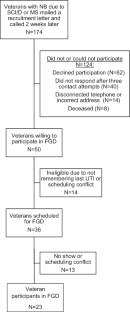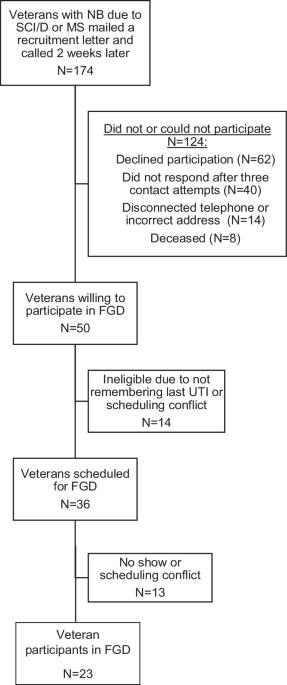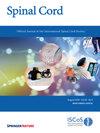Knowledge, perceptions, and beliefs about urinary tract infections in persons with neurogenic bladder and impacts on interventions to promote person-centered care
IF 2.1
4区 医学
Q3 CLINICAL NEUROLOGY
引用次数: 0
Abstract
Qualitative study. To explore how knowledge, perceptions, and beliefs about urinary tract infections (UTIs) among persons with neurogenic bladder (NB) may impact health behaviors and provider management and enhance person-centeredness of interventions to improve UTI management. Three Veterans Affairs (VA) medical centers. Adults with NB due to spinal cord injury/disorder (SCI/D) or multiple sclerosis (MS) with UTI diagnoses in the prior year participated in focus groups. Transcripts were coded using deductive codes linked to the Health Belief Model and inductive codes informed by grounded theory. Twenty-three Veterans (SCI/D, 78%; MS: 18.5%) participated in discussions. Three themes emerged: (1) UTI knowledge; (2) factors affecting the intervention environment; and (3) factors affecting modes of delivery. Knowledge gaps included UTI prevention, specific symptoms most indicative of UTI, and antibiotic side effects. Poor perceptions of providers lacking knowledge about NB and ineffective patient–provider communication were common in the Emergency Department and non-VA facilities, whereas participants had positive perceptions of home-based care. Participants perceived lower severity and frequency of antibiotic risks compared to UTI risks. Participant preferences for education included caregiver involvement, verbal and written materials, and diverse settings like peer groups. Identifying patient perspectives enhances person-centeredness and allows for novel interventions improving patient knowledge and behaviors about UTIs. Partnering with trusted providers and home-based caregivers and improving NB knowledge and communication in certain care settings were important. Patient education should address mental risk representations and incorporate preferences for content delivery to optimize self-efficacy and strengthen cues to action.


关于神经源性膀胱患者尿路感染的知识、看法和信念,以及对促进以人为本的护理的干预措施的影响
研究设计定性研究目的探讨神经源性膀胱(NB)患者对尿路感染(UTI)的知识、看法和信念会如何影响健康行为和医疗服务提供者的管理,以及如何加强以人为本的干预措施以改善 UTI 管理。使用与健康信念模型相关联的演绎代码和基础理论的归纳代码对讨论记录进行编码。讨论中出现了三个主题:(1) UTI 知识;(2) 影响干预环境的因素;(3) 影响提供方式的因素。知识缺口包括尿毒症的预防、尿毒症最常见的具体症状以及抗生素的副作用。在急诊科和非退伍军人医疗机构中,参与者普遍认为医疗服务提供者缺乏有关 NB 的知识,患者与医疗服务提供者之间的沟通效率低下,而参与者则对家庭护理有积极的看法。与尿毒症风险相比,参与者认为抗生素风险的严重性和频率较低。参与者对教育的偏好包括护理人员的参与、口头和书面材料,以及同侪团体等多样化的环境。与可信赖的医疗服务提供者和居家护理人员合作,以及在特定护理环境中改善 NB 知识和沟通都很重要。患者教育应针对心理风险表征,并结合对内容提供的偏好,以优化自我效能并加强行动提示。
本文章由计算机程序翻译,如有差异,请以英文原文为准。
求助全文
约1分钟内获得全文
求助全文
来源期刊

Spinal cord
医学-临床神经学
CiteScore
4.50
自引率
9.10%
发文量
142
审稿时长
2 months
期刊介绍:
Spinal Cord is a specialised, international journal that has been publishing spinal cord related manuscripts since 1963. It appears monthly, online and in print, and accepts contributions on spinal cord anatomy, physiology, management of injury and disease, and the quality of life and life circumstances of people with a spinal cord injury. Spinal Cord is multi-disciplinary and publishes contributions across the entire spectrum of research ranging from basic science to applied clinical research. It focuses on high quality original research, systematic reviews and narrative reviews.
Spinal Cord''s sister journal Spinal Cord Series and Cases: Clinical Management in Spinal Cord Disorders publishes high quality case reports, small case series, pilot and retrospective studies perspectives, Pulse survey articles, Point-couterpoint articles, correspondences and book reviews. It specialises in material that addresses all aspects of life for persons with spinal cord injuries or disorders. For more information, please see the aims and scope of Spinal Cord Series and Cases.
 求助内容:
求助内容: 应助结果提醒方式:
应助结果提醒方式:


